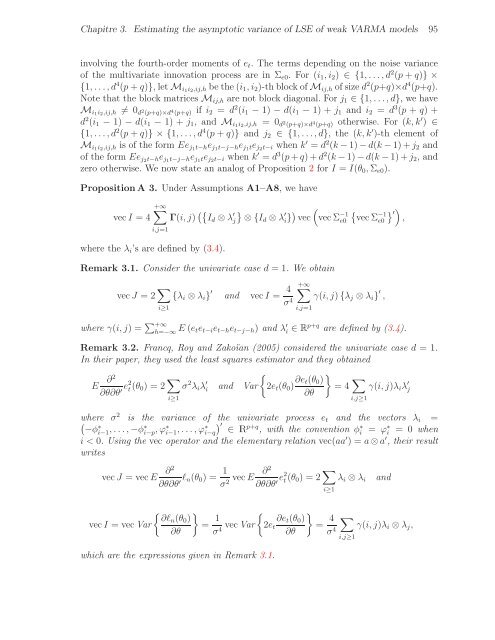THÈSE Estimation, validation et identification des modèles ARMA ...
THÈSE Estimation, validation et identification des modèles ARMA ...
THÈSE Estimation, validation et identification des modèles ARMA ...
Create successful ePaper yourself
Turn your PDF publications into a flip-book with our unique Google optimized e-Paper software.
Chapitre 3. Estimating the asymptotic variance of LSE of weak V<strong>ARMA</strong> models 95<br />
involving the fourth-order moments of <strong>et</strong>. The terms depending on the noise variance<br />
of the multivariate innovation process are in Σe0. For (i1,i2) ∈ {1,...,d 2 (p+q)} ×<br />
{1,...,d 4 (p+q)}, l<strong>et</strong>Mi1i2,ij,h be the(i1,i2)-th block ofMij,h of sized 2 (p+q)×d 4 (p+q).<br />
Note that the block matrices Mij,h are not block diagonal. For j1 ∈ {1,...,d}, we have<br />
Mi1i2,ij,h = 0 d 2 (p+q)×d 4 (p+q) if i2 = d 2 (i1 − 1) − d(i1 − 1) + j1 and i2 = d 3 (p + q) +<br />
d 2 (i1 − 1) − d(i1 − 1) + j1, and Mi1i2,ij,h = 0d 2 (p+q)×d 4 (p+q) otherwise. For (k,k ′ ) ∈<br />
{1,...,d 2 (p+q)} × {1,...,d 4 (p+q)} and j2 ∈ {1,...,d}, the (k,k ′ )-th element of<br />
Mi1i2,ij,h is of the form Eej1t−hej1t−j−hej1tej2t−i when k ′ = d 2 (k−1)−d(k−1)+j2 and<br />
of the form Eej2t−hej1t−j−hej1tej2t−i when k ′ = d 3 (p+q)+d 2 (k−1)−d(k−1)+j2, and<br />
zero otherwise. We now state an analog of Proposition 2 for I = I(θ0,Σe0).<br />
PropositionA 3. Under Assumptions A1–A8, we have<br />
vecI = 4<br />
+∞<br />
i,j=1<br />
Γ(i,j) Id ⊗λ ′ j<br />
where the λi’s are defined by (3.4).<br />
<br />
⊗{Id ⊗λ ′ i} <br />
vec vecΣ −1<br />
e0<br />
Remark 3.1. Consider the univariate case d = 1. We obtain<br />
vecJ = 2 <br />
{λi ⊗λi} ′<br />
i≥1<br />
and vecI = 4<br />
σ 4<br />
+∞<br />
i,j=1<br />
<br />
−1 ′<br />
vecΣe0 ,<br />
γ(i,j){λj ⊗λi} ′ ,<br />
where γ(i,j) = +∞<br />
h=−∞ E(<strong>et</strong><strong>et</strong>−i<strong>et</strong>−h<strong>et</strong>−j−h) and λ ′ i ∈ Rp+q are defined by (3.4).<br />
Remark 3.2. Francq, Roy and Zakoïan (2005) considered the univariate case d = 1.<br />
In their paper, they used the least squares estimator and they obtained<br />
E ∂2<br />
∂θ∂θ ′e2t (θ0) = 2 <br />
σ 2 λiλ ′ <br />
i and Var 2<strong>et</strong>(θ0) ∂<strong>et</strong>(θ0)<br />
<br />
= 4<br />
∂θ<br />
<br />
γ(i,j)λiλ ′ j<br />
i≥1<br />
where σ2 is the variance of the univariate process <strong>et</strong> and the vectors λi <br />
=<br />
∗ −φi−1 ,...,−φ ∗ i−p ,ϕ∗i−1 ,...,ϕ∗ ′ p+q ∗<br />
i−q ∈ R , with the convention φi = ϕ∗ i = 0 when<br />
i < 0. Using the vec operator and the elementary relation vec(aa ′ ) = a⊗a ′ , their result<br />
writes<br />
vecJ = vecE ∂2<br />
∂θ∂θ ′ℓn(θ0) = 1<br />
σ<br />
<br />
∂ℓn(θ0)<br />
vecI = vec Var<br />
∂θ<br />
2 vecE ∂2<br />
i,j≥1<br />
∂θ∂θ ′e2t (θ0) = 2 <br />
λi ⊗λi and<br />
i≥1<br />
= 1<br />
<br />
∂<strong>et</strong>(θ0)<br />
vec Var 2<strong>et</strong> =<br />
σ4 ∂θ<br />
4<br />
σ4 which are the expressions given in Remark 3.1.<br />
<br />
γ(i,j)λi ⊗λj,<br />
i,j≥1
















